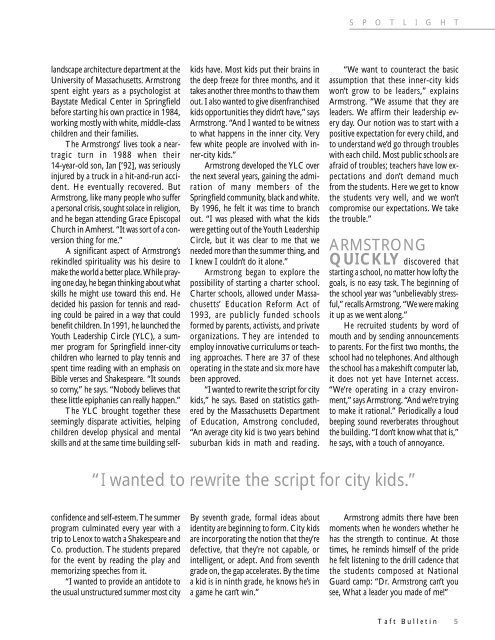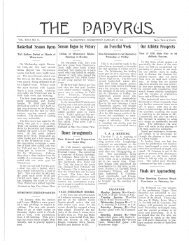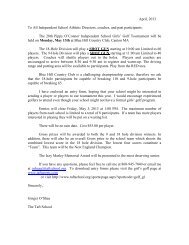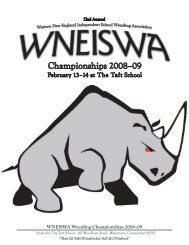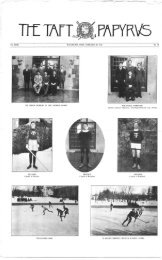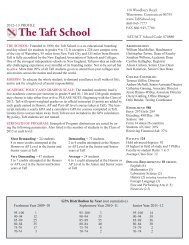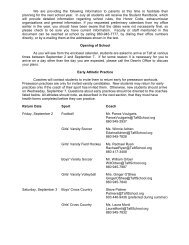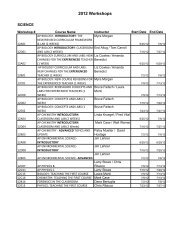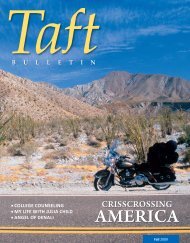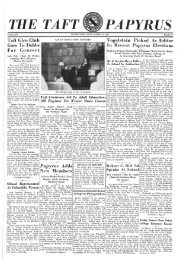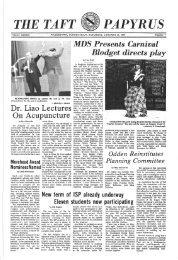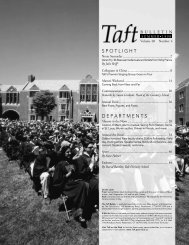By Lauren Henry '99 - The Taft School
By Lauren Henry '99 - The Taft School
By Lauren Henry '99 - The Taft School
- No tags were found...
Create successful ePaper yourself
Turn your PDF publications into a flip-book with our unique Google optimized e-Paper software.
S P O T L I G H Tkids have. Most kids put their brains inthe deep freeze for three months, and ittakes another three months to thaw themout. I also wanted to give disenfranchisedkids opportunities they didn’t have,” saysArmstrong. “And I wanted to be witnessto what happens in the inner city. Veryfew white people are involved with inner-citykids.”Armstrong developed the YLC overthe next several years, gaining the admirationof many members of theSpringfield community, black and white.<strong>By</strong> 1996, he felt it was time to branchout. “I was pleased with what the kidswere getting out of the Youth LeadershipCircle, but it was clear to me that weneeded more than the summer thing, andI knew I couldn’t do it alone.”Armstrong began to explore thepossibility of starting a charter school.Charter schools, allowed under Massachusetts’Education Reform Act of1993, are publicly funded schoolsformed by parents, activists, and privateorganizations. <strong>The</strong>y are intended toemploy innovative curriculums or teachingapproaches. <strong>The</strong>re are 37 of theseoperating in the state and six more havebeen approved.“I wanted to rewrite the script for citykids,” he says. Based on statistics gatheredby the Massachusetts Departmentof Education, Amstrong concluded,“An average city kid is two years behindsuburban kids in math and reading.“We want to counteract the basicassumption that these inner-city kidswon’t grow to be leaders,” explainsArmstrong. “We assume that they areleaders. We affirm their leadership everyday. Our notion was to start with apositive expectation for every child, andto understand we’d go through troubleswith each child. Most public schools areafraid of troubles; teachers have low expectationsand don’t demand muchfrom the students. Here we get to knowthe students very well, and we won’tcompromise our expectations. We takethe trouble.”ARMSTRONGQUICKLY discovered thatstarting a school, no matter how lofty thegoals, is no easy task. <strong>The</strong> beginning ofthe school year was “unbelievably stressful,”recalls Armstrong. “We were makingit up as we went along.”He recruited students by word ofmouth and by sending announcementsto parents. For the first two months, theschool had no telephones. And althoughthe school has a makeshift computer lab,it does not yet have Internet access.“We’re operating in a crazy environment,”says Armstrong. “And we’re tryingto make it rational.” Periodically a loudbeeping sound reverberates throughoutthe building. “I don’t know what that is,”he says, with a touch of annoyance.“I wanted to rewrite the script for city kids.”landscape architecture department at theUniversity of Massachusetts. Armstrongspent eight years as a psychologist atBaystate Medical Center in Springfieldbefore starting his own practice in 1984,working mostly with white, middle-classchildren and their families.<strong>The</strong> Armstrongs’ lives took a neartragicturn in 1988 when their14-year-old son, Ian [’92], was seriouslyinjured by a truck in a hit-and-run accident.He eventually recovered. ButArmstrong, like many people who suffera personal crisis, sought solace in religion,and he began attending Grace EpiscopalChurch in Amherst. “It was sort of a conversionthing for me.”A significant aspect of Armstrong’srekindled spirituality was his desire tomake the world a better place. While prayingone day, he began thinking about whatskills he might use toward this end. Hedecided his passion for tennis and readingcould be paired in a way that couldbenefit children. In 1991, he launched theYouth Leadership Circle (YLC), a summerprogram for Springfield inner-citychildren who learned to play tennis andspent time reading with an emphasis onBible verses and Shakespeare. “It soundsso corny,” he says. “Nobody believes thatthese little epiphanies can really happen.”<strong>The</strong> YLC brought together theseseemingly disparate activities, helpingchildren develop physical and mentalskills and at the same time building selfconfidenceand self-esteem. <strong>The</strong> summerprogram culminated every year with atrip to Lenox to watch a Shakespeare andCo. production. <strong>The</strong> students preparedfor the event by reading the play andmemorizing speeches from it.“I wanted to provide an antidote tothe usual unstructured summer most city<strong>By</strong> seventh grade, formal ideas aboutidentity are beginning to form. City kidsare incorporating the notion that they’redefective, that they’re not capable, orintelligent, or adept. And from seventhgrade on, the gap accelerates. <strong>By</strong> the timea kid is in ninth grade, he knows he’s ina game he can’t win.”Armstrong admits there have beenmoments when he wonders whether hehas the strength to continue. At thosetimes, he reminds himself of the pridehe felt listening to the drill cadence thatthe students composed at NationalGuard camp: “Dr. Armstrong can’t yousee, What a leader you made of me!”<strong>Taft</strong> Bulletin 5


